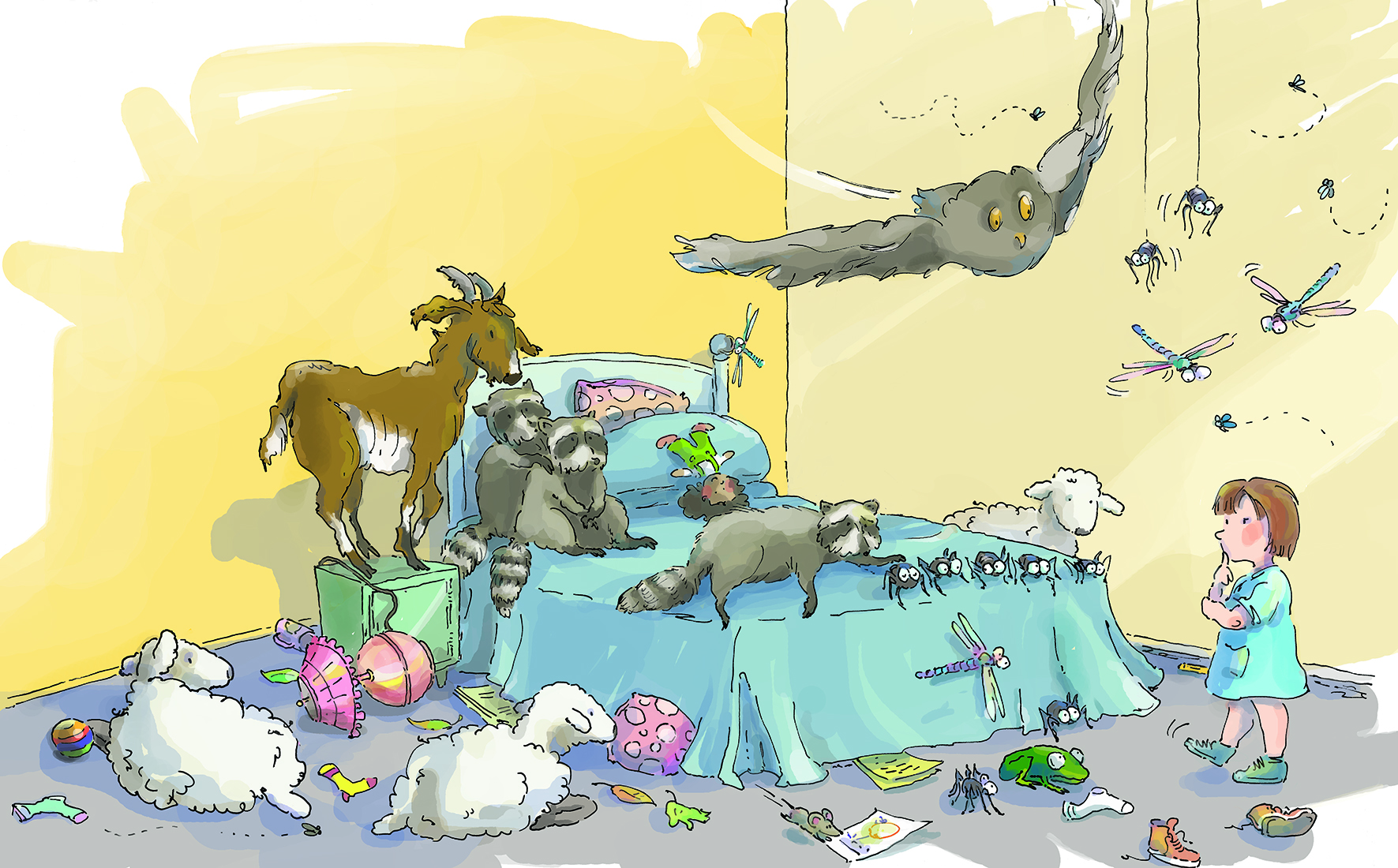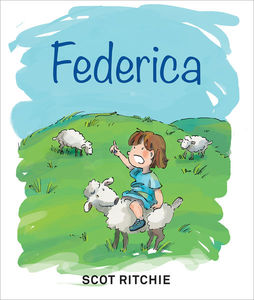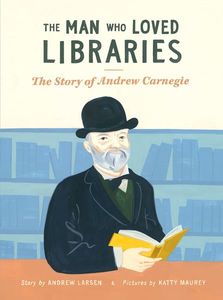Talking to Picture Book Creators - Part One
By Susan Hughes
Admit it: Don’t you just wish you were me sometimes?
Because when I recently came across four super picture books—A Bedtime Yarn by Nicola Winstanley, The Walking Bathroom by Shauntay Grant, Federica by Scot Ritchie, and The Man Who Loved Libraries: The Story of Andrew Carnegie by Andrew Larsen—and wanted to find out more about their creators, I sent each one a message, asking if they’d participate in a blog Q and A! And each one said yes.
So, I was able to ask them eight—well, nine, really—questions and find out many of the things I wanted to know. Nice, right? You’re wishing you were me right now, aren’t you?
Well, not to worry: because of course I am very pleased to be able to share these wonderful responses with you right here.
Susan Hughes:
What three children’s books are of importance to you, and why?
Nicola Winstanley:
I have a copy of Harvey’s Hideout by Russell and Lillian Hoban that my mother put in my Christmas stocking when I must have been about four or five. My mother died about a year later, and I still have the book. It’s important to me because it reminded me my whole life how important books and reading were to my mother.
Sorry to be incredibly clichéd, but The Lion the Witch and the Wardrobe had a huge influence on me. I was not a happy child and the book allowed me to escape into a beautiful place where good and bad were clear and children were powerful.
And then Harry Potter, of course, because I read every single word aloud to my own children and I was constantly annoyed by the too many adverbs and what I thought was excessive scenic detail, until I realized that it was these things that were helping my kids to be utterly entranced—so I learned a lot about the difference between what adults like when they’re reading and what kids like.
Shauntay Grant:
The Balloon Tree, by Phoebe Gilman, is one of my all-time faves from childhood. The story and illustrations are magical, colourful and playful.
Your CanLit News
Subscribe to Open Book’s newsletter to get local book events, literary content, writing tips, and more in your inbox
The Dot, by Peter H. Reynolds, is a great story to inspire creativity in even the most reluctant young artists.
Mufaro’s Beautiful Daughters, John Steptoe: As a child I was a huge Reading Rainbow fan. This was one of my most memorable reads from the series.
Scot Ritchie:
Leander the Gander by David and Sharon Stearns is a book I’m sure nobody will know but it’s the first book I can remember really enjoying as a kid. Part of that might have been that it was a double book (flip the cover and you could read Spunky the Donkey).
Anything by Sempe is a favourite; his illustrations are brilliant. I love his washed-out colours and laser point wit. He communicates more with imagery than words, something I can relate to.
Recently I had the great opportunity to be a judge for an award and I got to read a wide range of books I would otherwise not have seen. The one I remember most was the Night Gardener by Jonathan Auxier. It was a wonderful read.
Andrew Larsen:
I can think of so many children’s books that are important to me for one reason or another. Here are a few:
Peepo! by Janet and Alan Ahlberg. I began writing for children when my daughter was very young. I was trying to write something similar to the stories we were reading. Peepo! was a big favourite. It is also extremely performative. I marvel at how a text can delight both the reader and the listener again and again and again.
Poppleton by Cynthia Rylant. As my daughter grew older she wanted more sophisticated texts. We discovered Poppleton and were delighted by the world created by Cynthia Rylant. The stories are simple and small. There are three stories to a book and each is an exquisite part of a greater whole.
Tales of a Fourth Grade Nothing by Judy Blume. I love the comedic and insightful realism of all of Judy Blume’s Fudge books. Their slice-of-life quality inspired me as I wrote my middle grade novel Dingus. My kids LOVED these books and so do I!
Susan:
Any thoughts you’d like to share with us on agents?
Nicola:
I don’t currently have an agent and I think that’s pretty typical for picture book authors. I guess I got lucky on my first book, and then I had my foot in the door. However, I am looking for an agent, because I’m now writing YA and middle grade too and I feel I’m going to need some help here to get my writing seen by editors—publishers can whip through a slush pile of picture books pretty quickly themselves.
Scot:
I have an agent in the U.S. but not in Canada. I did have an agent for 15 years in Toronto but that was previous to my career doing kids books. Because I lived in Toronto for many years, I consider a number of the publishers there friends. I found I didn’t need, or want, an agent in Canada a result of that.
Andrew:
I’m represented by Fiona Kenshole (Transatlantic Literary Agency). I’ve been with Fiona for a few years now. She’s one of my biggest cheerleaders. Whenever I feel washed up (which happens to all writers) she is able to boost my confidence and get me back to work. She takes care of my contracts so that I can concentrate on writing. At the end of the day, I know Fiona has my back and my professional interests at heart. She has also taught me that, while writing is an art, publishing is a business.
Susan:
And now, two writing questions: a) What is your process for writing a picture book?
Nicola:
It usually starts with an image or concept—a baby stops crying when it smells cinnamon, a bed misses its dreamer, a child holds a ball of yard to fall asleep (and all these things come directly from my own experience). I sit with that image—sometimes a really long time!
Sometimes I think about it. Sometimes I don’t think about it; I just leave it there and let my subconscious do some work. Then, when I do the actual writing, the first draft is very quick because I’ve already worked out a lot of the knots in my head. Then I let it sit, go back to it, let it sit, go back to it. But honestly, that first draft, for me, is never very far off the finished version.
Shauntay:
It’s different for every book. With my first children’s story, I didn’t even set out to write a picture book – it was a poem for my family and community. My second picture book had its first life as a performance poem commissioned by CBC radio. And my third picture book is a reworking of a poem commissioned for an anthology.
My most recent book for children, The Walking Bathroom (Nimbus, 2017), is actually the first children’s story I wrote that was conceived as a picture book from the start.
Scot:
It can vary a lot depending on the genre. A non-fiction book like See What We Eat (Kids Can Press) is part of a series so characters and tone are already set. That makes it easier in some ways and harder in others.
Federica (Groundwood) is fiction so I approached it differently. It was inspired by a good friend and her daughter, Federica. The story actually started from a sketch I did and I added more rough sketches, almost like a cartoon. Once I could see it I started writing. Also, having a muse is a help because that kernel is always there to build from.
Andrew:
Something has to spark my interest or imagination in order to get the whole process started. Then, I’ll let that idea simmer. It might take a week. It might take a month. Finally, if the idea continues to simmer, I’ll get a sense that it’s time to sit down and write. Usually, as I sit down, I have no idea where the story will ultimately go. It’s a beautiful surprise.
Susan:
And b) How do you know when your idea is going to “work”? How do you know when your manuscript finished and ready to submit to your agent/editor?
Nicola:
I suppose in some ways, I’ve answered that above! But, I’m not always right—I have had a lot of things rejected. Lots of very good things get rejected, for all kinds of reasons. But, so do things that aren’t very good—aren’t finished, aren’t carefully considered, aren’t original, aren’t correct in grammar. So, we do have to be honest with ourselves when we get a rejection; perhaps it’s just not there yet. Perhaps it never will be. Keep reading and keep writing and get better at it.
Shauntay:
I try to get the manuscript to a place where I feel the story has settled, and then seek input or editorial advice from there. Generally when it “feels right,” I know I’m ready to submit.
Scot:
This is such a great question. The short answer is you know when the box of books arrives from the publisher. Until then you would swear it’s ready but then an editor or publisher begs to differ. They know their stuff so I listen to them. Invariably their advice improves what I thought was ready for the world.
Andrew:
It’s sort of like taking a walk. I take one step and then another. I know the idea is working if the journey seems worth continuing. Sometimes, I get stuck for a little bit. Sometimes, I get lost. Sometimes, I give up altogether. But I know it’s going well when the journey is leading somewhere new and when I’m excited to explore the new territory.
I know I’m ready to submit the manuscript when I can read it over and over again without making even the slightest revision. I also believe in reading the story aloud. Over and over again. My picture books are usually read that way. Submitting the manuscript marks the beginning of a whole new collaborative journey with my agent and then my editor.
Nicola Winstanley is a picture-book author who also writes fiction, poetry and comix for adults. She lives in Hamilton, Ontario. Her website is in progress!
Shauntay Grant is the author of several children’s books and she teaches creative writing at Dalhousie University in Halifax. She is Halifax’s third Poet Laureate (2009–11). Her website is shauntaygrant.com.
Scot Ritchie is an award winning illustrator and author who lives in Vancouver, British Columbia. He loves to draw and is in the process of learning to love to write. His website is www.scotritchie.com.
Andrew Larsen lives in a neighbourhood in Toronto, Ontario, that has tall trees, old houses and plenty of stories. Sometimes Andrew goes looking for stories and sometimes stories come looking for him. His website is www.andrewlarsen.ca.
Stay tuned for part two, coming next month on Open Book.
The views expressed by Open Book columnists are those held by the authors and do not necessarily reflect the views of Open Book.
Susan Hughes is an award-winning author of children's books — both fiction and non-fiction — including The Island Horse, Off to Class, Case Closed?, No Girls Allowed and Earth to Audrey. She is also an editor, journalist and manuscript evaluator. Susan lives in Toronto. Visit her website, www.susanhughes.ca.








